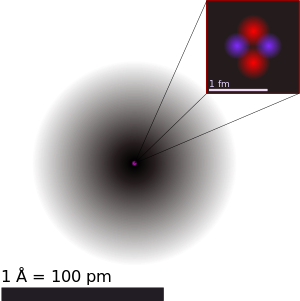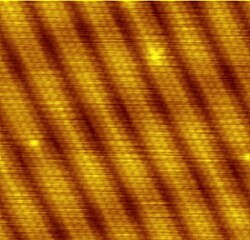अणु
| अणु | ||||||||
|---|---|---|---|---|---|---|---|---|
 | ||||||||
| A depiction of the atomic structure of the atom of helium. The darkness of the electron cloud corresponds to the line-of-sight integral over the probability function of the 1s electron orbital. The nucleus is, showing protons in purple and neutrons in pink. In reality, the nucleus (and the wavefunction of each of the nucleons) is also spherically symmetric. (For more complicated nuclei this is not the case.) | ||||||||
| वर्गिकरण | ||||||||
| ||||||||
| गुण | ||||||||
|
रसायनशास्त्र व भौतिकशास्त्रय् अणु तत्त्वया रसायनिक गुण दुगु दक्ले चिधंगु वस्तु ख।
छगू अणूय् पोजितिभ चार्ज दुगु प्रोतोन व चार्ज मदुगु न्युत्रोन जाना ताकुगु आणविक न्युक्लियस देकातै, थ्व न्युक्लियसया पिने न्युक्लियस स्वया तधंगु तर देन्सिती म्हो जुगु इलेक्त्रोन क्लाउद दै गुकिलि नेगेतिभ चार्ज दुगु इलेक्त्रोन दै। छगू अणुइ प्रोतोन व इलेक्त्रोनया संख्या उलि हे दःसा अणु इलेक्त्रिकल्ली न्युत्रल जुइ। छगू अणुइ प्रोतोनया ल्याखँ नं व अणुया तत्त्व सीकेफै धाःसा न्युत्रोनया ल्याखँ नं आइसोतोप सीकेफै।
इतिहास
[सम्पादन]The concept that matter is composed of discrete units and can not be divided into any arbitrarily tiny or small quantities has been around for thousands of years. The earliest references to the concept of atoms date back to ancient India in the 6th century BCE. [२] The Nyaya and Vaisheshika schools developed elaborate theories of how atoms combined into more complex objects (first in pairs, then trios of pairs). [३] The references to atoms in West, emerge a century later by Leucippus whose student, Democritus, systemized his views. In around 450 BCE, Democritus coined the term atomos, which meant "uncuttable". Though both the Indian and Greek concepts of the atom were based purely on philosophy, modern science has retained the name coined by Democritus.

In 1803, John Dalton used the concept of atoms to explain why elements always reacted in simple proportions, and why certain gases dissolved better in water than others. He proposed that each element consists of atoms of a single, unique type, and that these atoms could join to each other, to form compound chemical.
In 1827 a British botanist Robert Brown used a microscope to look at dust grains floating in water. He called their erratic motion "Brownian motion". Albert Einstein would later demonstrate that this motion was due to the water molecules bombarding the grains.
In 1897, JJ Thomson, through his work on cathode rays, discovered the electron and its subatomic nature, which destroyed the concept of atoms as being indivisible units. Later, Thomson also discovered the existence of isotopes through his work on ionized gases.
Thomson believed that the electrons were distributed evenly throughout the atom, balanced by the presence of a uniform sea of positive charge. However, in 1909, the gold foil experiment was interpreted by Ernest Rutherford as suggesting that the positive charge of an atom and most of its mass was concentrated in a nucleus at the center of the atom (Rutherford model), with the electrons orbiting it like planets around a sun. In 1913, Niels Bohr added quantum mechanics into this model, which now stated that the electrons were locked or confined into clearly defined orbits, and could jump between these, but could not freely spiral inward or outward in intermediate states.
In 1926, Erwin Schrodinger, using Louis DeBroglie's 1924 proposal that all particles behave to an extent like waves, developed a mathematical model of the atom that described the electrons as three-dimensional waveforms, rather than point particles. A consequence of using waveforms to describe electrons, pointed out by Werner Heisenberg a year later, is that it is mathematically impossible to obtain precise values for both the position and momentum of a particle at any point in time; this became known as the uncertainty principle. In this concept, for any given value of position one could only obtain a range of probable values for momentum, and vice versa. Although this model was difficult to visually conceptualize, it was able to explain many observations of atomic behavior that previous models could not, such as certain structural and spectral patterns of atoms bigger than hydrogen. Thus, the planetary model of the atom was discarded in favor of one that described orbital zones around the nucleus where a given electron is most likely to exist.
उप-आणविक वस्तुत
[सम्पादन]न्हापा न्हापा अणु धागु खँग्वः सैद्धान्तिक तवं तक्ले चिधंगु वस्तुयात जनाउ यायेत छ्य्ला तसां आःवया आधुनिक वैज्ञानिक परिक्षणं अणुया दुने नं उप-आणविक पार्तिकल लुइकाहगु दु। उप-आणविक पार्तिकलत थ्व कथं दु:
- इलेक्त्रोन, which have a negative charge, a size which is so small as to be currently unmeasurable, and which are the least heavy (i.e., massive) of the three types of basic particles, with an mass of 9.11x10-31kg.
- प्रोतोन, which have a positive charge, with a free mass about 1836 times more than electrons (mass of 1.67x10-27kg though binding energy changes can reduce this).
- न्युत्रोन, which have no charge, have a free mass about 1839 times the mass of electrons, and about the same physical size as protons (which is on the order of 2.5x10-15 m in diameter, although the "surface" of a proton or neutron is not very sharply defined).
Protons and neutrons make up a dense, massive atomic nucleus, and are collectively called nucleons. The electrons form the much larger electron cloud surrounding the nucleus. Both protons and neutrons are themselves now thought to be composed of even more elementary particles, quarks.
Atoms of the same element have the same number of protons (called the atomic number). Within a single element, the number of neutrons may vary, determining the isotope of that element. The number of electrons associated with an atom is most easily changed, due to the lower energy of binding of electrons. The number of protons (and neutrons) in the atomic nucleus may also change, via nuclear fusion, nuclear fission, bombardment by high energy subatomic particles or photons, or certain (but not all) types of radioactive decay. In such processes which change the number of protons in a nucleus, the atom becomes an atom of a different chemical element.
Atoms are electrically neutral if they have an equal number of protons and electrons. Atoms which have either a deficit or a surplus of electrons are called ions. Electrons that are furthest from the nucleus may be transferred to other nearby atoms or shared between atoms. By this mechanism atoms are able to bond into molecules and other types of chemical compounds like ionic and covalent network crystals.
अणु व मोलेक्युल
[सम्पादन]
For gases and certain molecular liquids and solids (such as water and sugar), molecules are the smallest division of matter which retains chemical properties; however, there are also many solids and liquids which are made of atoms, but do not contain discrete molecules (such as salts, rocks, and liquid and solid metals). Thus, while molecules are common on Earth (making up all of the atmosphere and most of the oceans), most of the mass of the Earth (much of the crust, and all of the mantle and core) is not made of identifiable molecules, but rather represents atomic matter in other networked arrangements, all of which lack the particular type of small-scale interrupted order (i.e., small, strongly-bound collections of atoms held to other collections of atoms by much weaker forces) that is associated with molecular matter.
Most molecules are made up of multiple atoms; for example, a molecule of water is a combination of two hydrogen atoms and one oxygen atom. The term "molecule" in gases has been used as a synonym for the fundamental particles of the gas, whatever their structure. This definition results in a few types of gases (for example inert elements that do not form compounds, such as neon), which has "molecules" consisting of only a single atom.
अणुया उत्त्पत्ति
[सम्पादन]The first nuclei, including most of the helium and all of the deuterium in the universe, were theoretically created during big bang nucleosynthesis, about 3 minutes after the big bang. The first atoms were theoretically created 380,000 years after the big bang, an epoch called recombination, when the universe cooled enough to allow electrons to become attached to nuclei. Since then, atoms have been combined in stars through the process of nuclear fusion to generate atoms up to Iron. Some atoms such as 6Li are generated in space through Cosmic ray spallation. Elements heavier than Iron were generated in supernovae through the r-process and in AGB stars through the s-process. Some elements, such as lead, formed largely through the radioactive decay of heavier elements.
Most of the atoms that currently make up the earth and all its inhabitants were present in their current form in the nebula that formed the solar system. The rest are the result of radioactive decay, and their relative proportion can be used to determine the age of the earth through radiometric dating. Most of the helium on earth is a product of alpha-decay.
There are a few trace atoms on Earth that were not present at the beginning, nor are results of radioactive decay. Carbon-14 is continuously generated by cosmic rays in the atmosphere. Some atoms on Earth have been artificially generated either deliberately or as by-products of nuclear reactors or explosions, including all the plutonium and technetium on the earth.
Size comparisons
[सम्पादन]Various analogies have been used to demonstrate the minuteness of the atom:
- A human hair is about 1 million carbon atoms wide.
- A single drop of water contains about 2 sextillion atoms of oxygen (2 followed by 21 zeros, 2×1021) and twice as many hydrogen atoms.[४]
- A HIV virion is the width of 800 carbon atoms and contains about 100 million atoms total. An E. coli bacterium contains perhaps 100 billion atoms, and a typical human cell roughly 100 trillion atoms.
- A speck of dust might contain 3x1012 (3 trillion) atoms.
- If an apple is magnified to the size of the earth, then the atoms in the apple are approximately the size of the original apple.[५]
स्वयादिसँ
[सम्पादन]लिधँसा
[सम्पादन]- ↑ Matthew Champion, "Re: How many atoms make up the universe?", 1998
- ↑ Gangopadhyaya, Mrinalkanti. Indian Atomism: History and Sources. Atlantic Highlands, New Jersey: Humanities Press, 1981. ISBN 0-391-02177-X
- ↑ https://web.archive.org/web/20071101013731/http://dbhs.wvusd.k12.ca.us/webdocs/AtomicStructure/Atom-Theory-in-India.html
- ↑ (2002) Prentice Hall Science Explorer. Upper Saddle River, New Jersey USA: Prentice-Hall, Inc.. ISBN 0-13-054091-9. Science textbook, Page 32: "There are 2,000,000,000,000,000,000,000 (that's 2 sextillion) atoms of oxygen in one drop of water—and twice as many atoms of hydrogen."
- ↑ Richard Feynman (1995). Six Easy Pieces. The Penguin Group. ISBN 978-0-14-027666-4.
- Kenneth S. Krane, Introductory Nuclear Physics (1987)
- Atomic and cosmic model of ferman (1975. [१]
पिनेया स्वापू
[सम्पादन]| Wikisource has the text of The New Student's Reference Work article Atom. |
| विकिमिडिया मंका य् थ्व विषय नाप स्वापु दुगु मिडिया दु: Atom |
- आणविक sizes
- How Atoms Work
- Wikibooks FHSST Physics Atom:The Atom
- विकिसफू आणविक संरचना
- Science aid - atomic structure A guide to the atom for teens.
| ||||||
| ||||||||||||||||||||||||||||||||||||||||||||||||||||||||||||||||||||||||||||||||||||
| विकिमिडिया मंका य् थ्व विषय नाप स्वापु दुगु मिडिया दु: Atoms |
